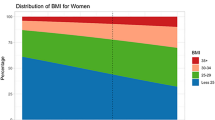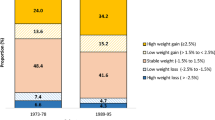Abstract
Background:
Obesity prevalence stabilized in the US in the first decade of the 2000s. However, obesity prevalence may resume increasing if younger generations are more sensitive to the obesogenic environment than older generations.
Methods:
We estimated cohort effects for obesity prevalence among young adults born in the 1980s. Using data collected from the National Health and Nutrition Examination Survey between 1971 and 2008, we calculated obesity for respondents aged between 2 and 74 years. We used the median polish approach to estimate smoothed age and period trends; residual non-linear deviations from age and period trends were regressed on cohort indicator variables to estimate birth cohort effects.
Results:
After taking into account age effects and ubiquitous secular changes, cohorts born in the 1980s had increased propensity to obesity versus those born in the late 1960s. The cohort effects were 1.18 (95% CI: 1.01, 1.07) and 1.21 (95% CI: 1.02, 1.09) for the 1979–1983 and 1984–1988 birth cohorts, respectively. The effects were especially pronounced in Black males and females but appeared absent in White males.
Conclusions:
Our results indicate a generational divergence of obesity prevalence. Even if age-specific obesity prevalence stabilizes in those born before the 1980s, age-specific prevalence may continue to rise in the 1980s cohorts, culminating in record-high obesity prevalence as this generation enters its ages of peak obesity prevalence.
This is a preview of subscription content, access via your institution
Access options
Subscribe to this journal
Receive 12 print issues and online access
$259.00 per year
only $21.58 per issue
Buy this article
- Purchase on Springer Link
- Instant access to full article PDF
Prices may be subject to local taxes which are calculated during checkout



Similar content being viewed by others
References
Flegal KM, Carroll MD, Kuczmarski RJ, Johnson CL . Overweight and obesity in the United States: prevalence and trends, 1960–1994. Int J Obes Relat Metab Disord 1998; 22: 39–47.
Flegal KM, Carroll MD, Ogden CL, Curtin LR . Prevalence and trends in obesity among US adults, 1999–2008. JAMA 2010; 303: 235–241.
Rokholm B, Baker JL, Sorensen TI . The levelling off of the obesity epidemic since the year 1999--a review of evidence and perspectives. Obes Rev 2010; 11: 835–846.
Faeh D, Bopp M . Increase in the prevalence of obesity in Switzerland 1982–2007: birth cohort analysis puts recent slowdown into perspective. Obesity (Silver Spring) 2010; 18: 644–646.
Reither EN, Olshansky SJ, Yang Y . New forecasting methodology indicates more disease and earlier mortality ahead for today's younger Americans. Health Aff (Millwood) 2011; 30: 1562–1568.
Lawlor DA, Timpson NJ, Harbord RM, Leary S, Ness A, McCarthy MI et al. Exploring the developmental overnutrition hypothesis using parental-offspring associations and FTO as an instrumental variable. PLoS Med 2008; 5: e33.
Gluckman PD, Hanson MA . The developmental origins of the metabolic syndrome. Trends Endocrinol Metab 2004; 15: 183–187.
Ravelli AC, van Der Meulen JH, Osmond C, Barker DJ, Bleker OP . Obesity at the age of 50 y in men and women exposed to famine prenatally. Am J Clin Nutr 1999; 70: 811–816.
Gluckman P, Hanson M . Developmental and epigenetic pathways to obesity: an evolutionary-developmental perspective. Int J Obesity 2008; 32: S62–S71.
Reither EN, Hauser RM, Yang Y . Do birth cohorts matter? Age-period-cohort analyses of the obesity epidemic in the United States. Soc Sci Med 2009; 69: 1439–1448.
Komlos J, Brabec M . The trend of BMI values of US adults by deciles, birth cohorts 1882–1986 stratified by gender and ethnicity. Econ Hum Biol 2011; 9: 234–250.
National Center for Health Statistics. Plan and operation of the health and nutrition examination survey. United States—1971–1973. Vital Health Stat; 1978; 1–407.
National Center for Health Statistics. Plan and operation of the Third National Health and Nutrition Examination Survey, 1988–94. Series 1: programs and collection procedures. Vital Health Stat; 1994; 1–46.
National Center for Health Statistics. Analytic and Reporting Guidelines: The National Health and Nutrition Examination Survey (NHANES), 2005.
Bates LM, Acevedo-Garcia D, Alegria M, Krieger N . Immigration and generational trends in body mass index and obesity in the United States: results of the National Latino and Asian American Survey, 2002–2003. Am J Public Health 2008; 98: 70–77.
Franzini L, Ribble JC, Keddie AM . Understanding the Hispanic paradox. Ethn Dis 2001; 11: 496–518.
Ryder NB . The cohort as a concept in the study of social change. Am Sociol Rev 1965; 30: 843–861.
Keyes KM, Li G . Age-period-cohort analysis in injury epidemiology. In: Li G, Baker SP (eds). Injury Research: Theories, Methods, Approaches. Springer: New York, 2011.
Keyes KM, Schulenberg JE, O'Malley PM, Johnston LD, Bachman JG, Li G et al. The social norms of birth cohorts and adolescent marijuana use in the United States, 1976–2007. Addiction 2011; 106: 1790–1800.
Keyes KM, Li G . A multiphase method for estimating cohort effects in age-period contingency table data. Ann Epidemiol 2010; 20: 779–785.
Yang Y . Aging, cohorts, and methods. In: The Handbook of Aging and the Social Sciences. 7 edn. Academic Press : Burlington, MA, 2010, pp 17–30.
Keyes KM, Utz RL, Robinson W, Li G . What is a cohort effect? Comparison of three statistical methods for modeling cohort effects in obesity prevalence in the United States, 1971–2006. Soc Sci Med 2010; 70: 1100–1108.
Keith SW, Redden DT, Katzmarzyk PT, Boggiano MM, Hanlon EC, Benca RM et al. Putative contributors to the secular increase in obesity: exploring the roads less traveled. Int J Obesity 2006; 30: 1585–1594.
Robinson WR . Gender-specific effects of early nutritional restriction on adult obesity risk: evidence from quasi-experimental studies. Obesity (Silver Spring) 2012; e-pub ahead of print 13 February 2012; doi:10.1038/oby.2012.35.
Eggebeen DJ, Lichter DT . Race, Family structure, and changing poverty among American children. Am Sociol Rev 1991; 56: 801–817.
Dunn GA, Morgan CP, Bale TL . Sex-specificity in transgenerational epigenetic programming. Horm Behav 2011; 59: 290–295.
Case A, Menendez A . Sex differences in obesity rates in poor countries: evidence from South Africa. Econ Hum Biol 2009; 7: 271–282.
Hult M, Tornhammar P, Ueda P, Chima C, Edstedt Bonamy AK, Ozumba B et al. Hypertension, diabetes and overweight: looming legacies of the biafran famine. PLoS One 5: e13582.
Merrill RM, Richardson JS . Validity of self-reported height, weight, and body mass index: findings from the National Health and Nutrition Examination Survey, 2001–2006. Prev Chronic Dis 2009; 6: A121.
Shiely F, Perry IJ, Lutomski J, Harrington J, Kelleher CC, McGee H et al. Temporal trends in misclassification patterns of measured and self-report based body mass index categories—findings from three population surveys in Ireland. BMC Public Health 2010; 10: 560.
Stommel M, Schoenborn CA . Accuracy and usefulness of BMI measures based on self-reported weight and height: findings from the NHANES & NHIS 2001–2006. BMC Public Health 2009; 9: 421.
Yang Y, Land KCA . Mixed models approach to age-period-cohort analysis of repeated cross-section surveys: trends in verbal test scores. Sociol Methodol 2006; 36: 75–97.
Burkhauser RV, Cawley J, Schmeiser MD . The timing of the rise in U.S. obesity varies with measure of fatness. Econ Hum Biol 2009; 7: 307–318.
Park J, Myers D, Kao D, Min S . Immigrant obesity and unhealthy assimilation: alternative estimates of convergence or divergence, 1995–2005. Soc Sci Med 2009; 69: 1625–1633.
Komlos J, Brabec M . The trend of mean BMI values of US adults, birth cohorts 1882–1986 indicates that the obesity epidemic began earlier than hitherto thought. Am J Hum Biol 2010; 22: 631–638.
Acknowledgements
We would like to thank Marissa J Seamans for editorial assistance and BoRin Kim for assistance in statistical programming. Dr Robinson would like to thank the Robert Wood Johnson Foundation Health & Society Scholars program for its financial support. Dr Keyes would like to thank Columbia University Department of Epidemiology and New York State Psychiatric Institute for its financial support. Dr Utz would like to thank the University of Utah Department of Sociology and NCI P01-CA13837 for current finacial support. Ms. Martin would like to thank the University of North Carolina at Chapel Hill and Grant no. 5-T32-HD052468-04 for current financial support. Dr Yang is supported by NIA Grant no. 1K01AG036745-01 and University Cancer Research Funds (UCRF) at the Lineberger Cancer Center at UNC-Chapel Hill.
Author information
Authors and Affiliations
Corresponding author
Ethics declarations
Competing interests
The authors declare no conflict of interest.
Rights and permissions
About this article
Cite this article
Robinson, W., Keyes, K., Utz, R. et al. Birth cohort effects among US-born adults born in the 1980s: foreshadowing future trends in US obesity prevalence. Int J Obes 37, 448–454 (2013). https://doi.org/10.1038/ijo.2012.66
Received:
Revised:
Accepted:
Published:
Issue Date:
DOI: https://doi.org/10.1038/ijo.2012.66
Keywords
This article is cited by
-
Gender Disparities in Blood Pressure and the Role of Body Mass Index: A Birth Cohort Analysis in China
Journal of Epidemiology and Global Health (2023)
-
Epidemiology of Obesity in Adults: Latest Trends
Current Obesity Reports (2018)
-
Age-specific changes in BMI and BMI distribution among Australian adults using cross-sectional surveys from 1980 to 2008
International Journal of Obesity (2015)
-
Projection scenarios of body mass index (2013–2030) for Public Health Planning in Quebec
BMC Public Health (2014)
-
Intakes of folate, methionine, vitamin B6, and vitamin B12 with risk of esophageal and gastric cancer in a large cohort study
British Journal of Cancer (2014)



